Honor Award
Catalina Foothills
Tucson, AZ USA
Design Workshop, Inc., Aspen, CO USA
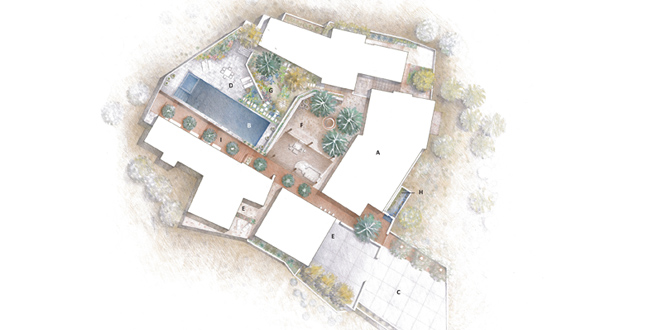 Close Me!
Close Me!The home is designed to emulate a series of little houses, arranged in a U-shape, with an open, multilevel courtyard. A long corridor connects the compound, transitioning from the enclosed front sanctuary to the broad vistas of the lower terrace.
Photo: Design Workshop, Inc.
Photo 1 of 15
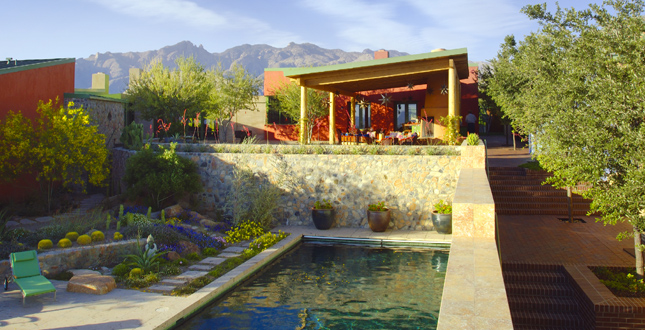 Close Me!
Close Me!The steep site created an opportunity for a dramatic drop between the upper dining and gathering portal and the quiet pool area. A fieldstone wall separates the "street" and guest quarters from the pool area.
Photo: D. A. Horchner / Design Workshop, Inc.
Photo 2 of 15
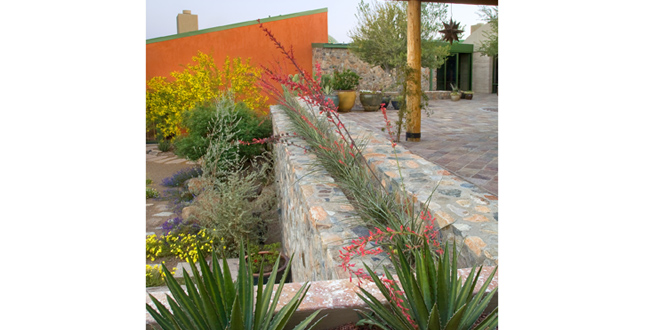 Close Me!
Close Me!A design element seen in Spanish colonial buildings, the landscape architect placed hesperaloe and agave in the top of a garden wall. The plantings help screen views and act as deterrents to anyone wanting to scale the walls.
Photo: D. A. Horchner / Design Workshop, Inc.
Photo 3 of 15
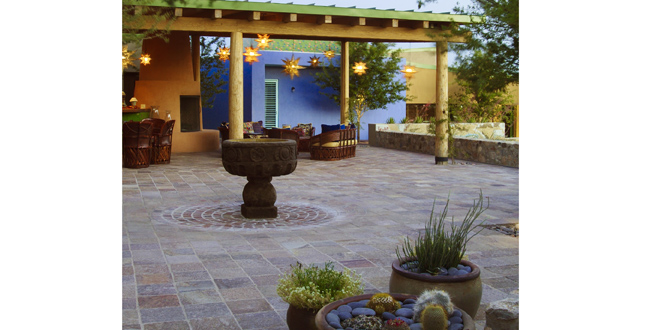 Close Me!
Close Me!The placita with its lanterns, climbing roses, and colorful Mexican-style decor is the focal point of the upper terrace. Three large native ironwood trees provide shade and cover. A trickle of water emanates from the fountain.
Photo: D. A. Horchner / Design Workshop, Inc.
Photo 4 of 15
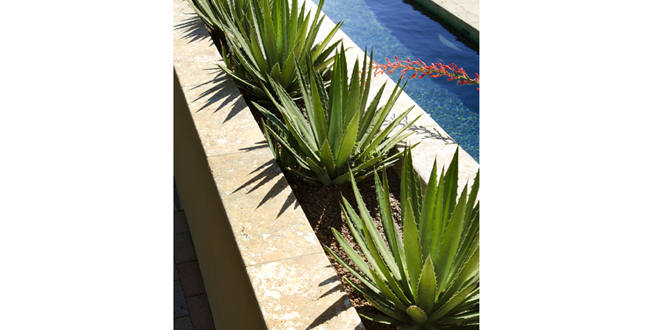 Close Me!
Close Me!Agave parryii creates a colorful and crisp border along the vertical break.
Photo: D. A. Horchner / Design Workshop, Inc.
Photo 5 of 15
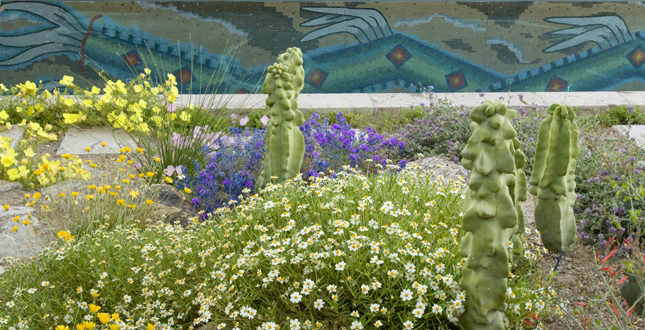 Close Me!
Close Me!The rich and complex planting palette which includes nearly 30 species of cacti and succulents, 20 species of native shrubs and 40 species of drought-tolerant ground cover challenges the notion that a modern garden must be a minimal garden.
Photo: D. A. Horchner / Design Workshop, Inc.
Photo 6 of 15
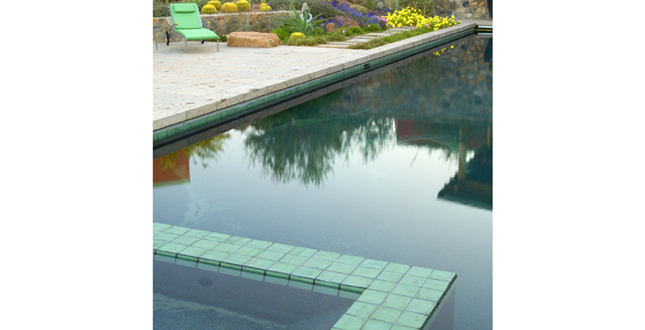 Close Me!
Close Me!The long, rectangular pool is deep enough for diving and includes a spa at one end. Pool tile and coordinating site furniture reflect the color turquoise, a color found throughout the Southwest.
Photo: D. A. Horchner / Design Workshop, Inc.
Photo 7 of 15
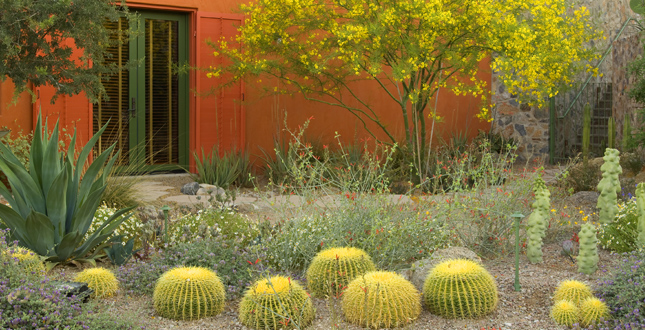 Close Me!
Close Me!Sandstone stepping-stones allow for passage through the desert garden surrounding the pool area. A blue paloverde tree (Parkinsonia florida) in bloom marks a stairway to the upper terrace.
Photo: D. A. Horchner / Design Workshop, Inc.
Photo 8 of 15
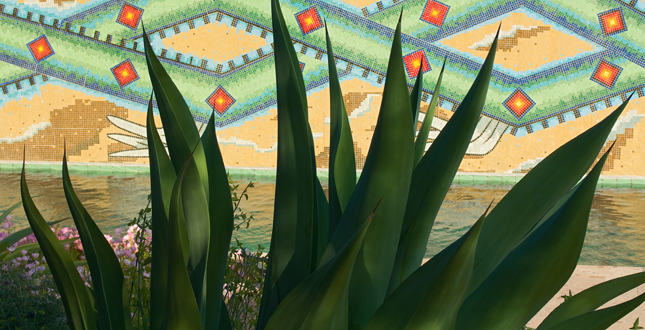 Close Me!
Close Me!A tile-mosaic mural, designed and installed by a Santa Fe artist, draws the eye to the water’s edge on the pool’s east wall.
Photo: D. A. Horchner / Design Workshop, Inc.
Photo 9 of 15
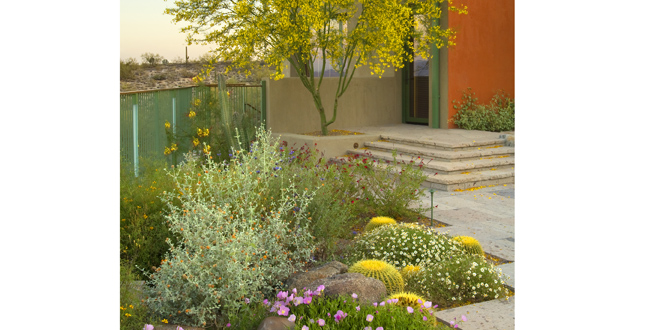 Close Me!
Close Me!The south wing’s angles and vivid wall color contrast with the softer, more organic colors, shapes, and textures of the lower terrace garden. Throughout the compound, a palette of native plants integrates the architecture with the surrounding desert landscape.
Photo: D. A. Horchner / Design Workshop, Inc.
Photo 10 of 15
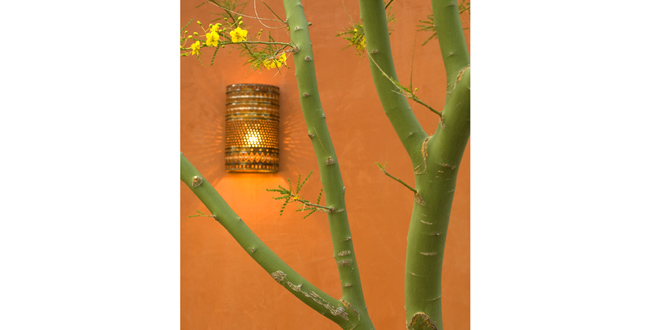 Close Me!
Close Me!A paloverde’s bark and blossoms are silhouetted against a wall.
Photo: D. A. Horchner / Design Workshop, Inc.
Photo 11 of 15
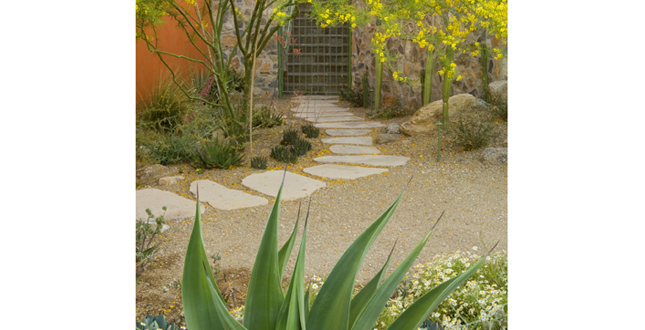 Close Me!
Close Me!Water in the desert restores a sense of life and brings forth a magical change in plants, animals, and insects. Water recycled from the home creates an abundance of color and texture in an otherwise dry and monochromatic landscape.
Photo: D. A. Horchner / Design Workshop, Inc.
Photo 12 of 15
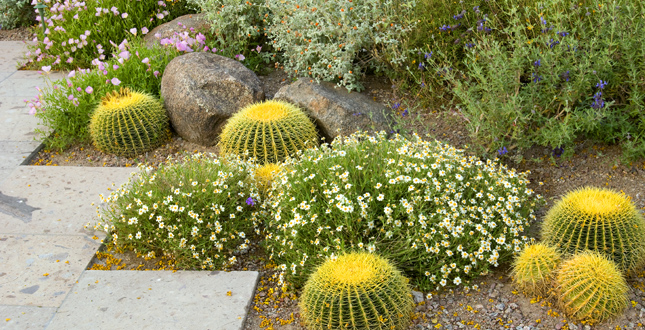 Close Me!
Close Me!Mounding barrel cactus and other clump-forming perennials soften the effect of geometric pavers and native granite boulders, which are used throughout the garden to establish a naturalized planting concept.
Photo: D. A. Horchner / Design Workshop, Inc.
Photo 13 of 15
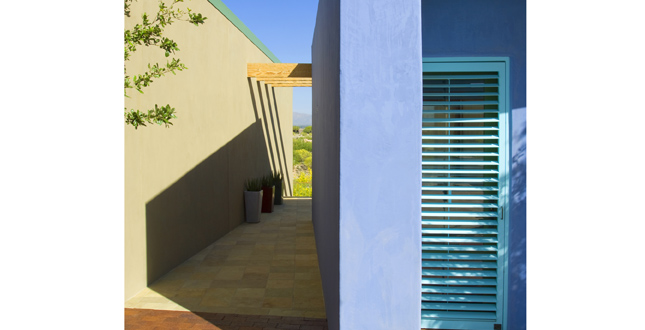 Close Me!
Close Me!The landscape architect studied the site’s wind patterns and potential microclimates that would be created by the house itself. More lush and fragile plantings were placed closer to the home, while the outlying desert would be preserved along the perimeter.
Photo: D. A. Horchner / Design Workshop, Inc.
Photo 14 of 15
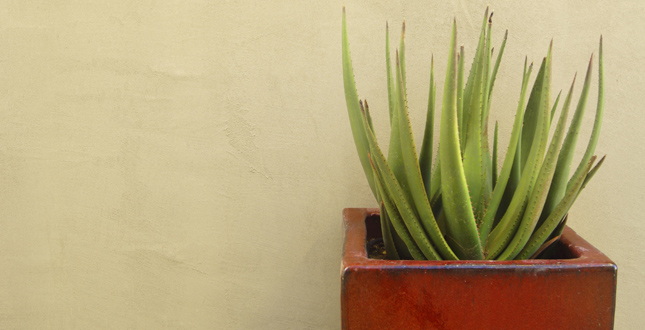 Close Me!
Close Me!Colorful, glazed pottery crafted in the Southwest, was planted with agaves, cacti and other succulents and placed strategically throughout the compound.
Photo: D. A. Horchner / Design Workshop, Inc.
Photo 15 of 15
Project Statement
Catalina Foothills, a modern home located in the suburban foothills of north Tucson, Arizona, illustrates excellence for its use of color, careful attention to the native vegetation palette, and water conservation. Designers implemented the region’s first graywater reuse system for a residential application, intended to reduce water consumption by approximately forty percent. Innovation, combined with a striking planting palette respective of its region, creates a notable environment for its owners and their guests.
Project Narrative
—2010 Professional Awards Jury
Introduction
The owners wanted to create a unique retreat for family and friends focused on the color, texture, and outdoor living environment of the desert Southwest. Inspiration for the home comes from the history and living environment of the desert Southwest. The landscape highlights the variety and richness of the many microclimates found in the Sonoran Desert. The architecture takes its cue from the Barrio Analco, the oldest neighborhood in Tucson, and other Spanish–Mexican colonial missions and plazas. Color-washed walls with deep alcoves, intimately scaled courtyards, clustered living spaces and gathering areas, water and shade are concepts that, when combined with the modernist aesthetic of the chosen architect, result in a family compound that resembles a small village of colorful houses cascading down a desert foothill. Contemporary art created by southwestern artists is integrated into the home and landscape to capture the color, senses, and texture of living in the desert.
Project Statement & Design Intent
A steep, north-facing driveway marks the approach to the property. Three ironwood trees, a hallmark tree in Tucson, stand silhouetted in formations in the courtyard. A gate laced with vertical strips of wood, marks the entrance into the auto court, while a painted iron gate allows passage into the front entry. Stone walls and a heavy Mexican door mark the main entrance to the house. A trickle fountain, much like a desert seep, flows down a site wall adjacent to the entry gate, its echoes reverberating in the intimate entry courtyard.
The home is designed to emulate a series of little houses, each with a slightly different color and character. It is arranged in a U-shape, with an open, multilevel courtyard, facing to the south. The main living areas of the home are clustered in the center. A ramada extends off the house, sheltering an outdoor kitchen, entertainment area and outdoor fireplace. A raised fountain, typical of those found in intimately scaled Mexican-style courtyards, fills the space with the sound of splashing water. Colorful pots, planted with agaves and cacti, are placed strategically within the space. A long corridor, or "street," connects the compound, transitioning from the enclosed sanctuary of the front entry to the broad vistas of the lower pool environment. Street trees in the form of Heritage oaks, line the narrow corridor which consists of guest suites to one side and the back side of the pool wall to the other. The trees, in combination with painted alcoves and shutters, provide privacy, shade and natural gathering points for users of the space.
The master suite and guest suites look to the east and west respectively. The master suite, characterized by rammed earthen walls and framed with sage green accents, sits unobtrusively to one side of the entertainment courtyard. The guest compound, highlighted by walls and shutters painted in bright hues of purple, orange and red, forms the eastern edge of the courtyard. The home is draped over a narrow finger hillside; 12 feet of vertical change exists between the main living area and the ends of the guest and master suite wings. Accommodating the substantial grade change satisfies the rudimentary topographic elements of the existing landscape; it also facilitates access from all areas within the house to the entertainment courtyard above and the swimming pool and garden areas below.
The landscape architect chose a palette of native plants whose color, texture and bloom sequence that would complement the modern lines and subtle tones of the architecture, and coincide with the time in which the owners are in residence. All areas beyond the immediate perimeter of the building were designed to mimic the existing conditions and mix of plant materials. Sonoran natives such as paloverde trees, brittle bush and creosote facilitate the natural sequence from built environment to native desert at the exterior of the property. Closer in, the master and guest wings are screened with ocotillo, blue agave and acacia trees, allowing for a glimpse of the variety of plant materials that exist in desert landscapes. In total, the landscape architect carefully crafted a planting design that includes nearly 30 varieties of cacti, agave and aloe, 20 varieties of drought-tolerant shrubs and 40 species of ground cover.
In the landscape areas interior to the building are found themes that reference Spanish colonial landscapes from missions and churchyards of northern Mexico and southern Arizona. In southwestern Spanish colonial urban areas, evergreen shade trees are a common feature in streets and plazas to provide coolness for people from the heat of the day. An entry "street"—a wide brick-laid walk that connects the guest parking area, entry courtyard and guest casitas—is planted with Heritage oaks to recreate this historic pattern. Three large native ironwood trees provide shade and cover in the upper placita/dining patio. Plantings on top of the walls reveal the implementation of yet another Spanish colonial pattern.
Special Factors & Significance
The goals of the design were many; however, two fundamental objectives were achieved that reinforce the challenge of landscape architecture in a desert climate. The successful permutation of color, texture and the variety and beauty of desert microclimates that exist in the Sonoran Desert environment, combined with the development of a water-wise strategy for the landscape including a greywater reuse irrigation system are the brainchild of a creative design team, and an enthusiastic homeowner.
Tucson, with its 12-inch annual precipitation, is one of the largest cities in the country to depend entirely on pumped groundwater for survival. Speculation about the future of that supply abounds, and landscape-related water application may become an anomaly. The opportunity to implement a greywater reuse system was timely as Arizona had just become one of the first states to create a greywater reuse ordinance. This system, the first to be applied in a residential scenario in the Tucson area, is tied to all the nonseptic plumbing fixtures, the pool filtration purge line, and all roof downspouts. It is intended to reduce water consumption for the landscape irrigation by approximately 40 percent.
Desert microclimates are driven primarily by shade and water availability. Additionally, all deserts offer a complexity of color, texture, and survival efficiency that, for a landscape architect, offer a mixed blessing of inherent challenge and ultimate reward. Tucson is a natural arboreal desert, meaning that it supports a great many trees and shrubs of all kinds. Catalina Foothills is located within an arid range of the greater Tucson desert that is characterized primarily by creosote bush, sustaining minimum winter temperatures of 28° F. The site, while adjacent to the foothills, is not close enough to receive the slight amount of extra water to create a richer landscape pattern. The home's water reuse system allows for the accumulation of just enough water to sustain a richer, more diverse environment.
Project Resources
Design Workshop Team Members
Faith Okuma
Claudia Meyer-Horn
Sergio Yamada
Wilbert Trujillo
Architect
Suby Bowden, Santa Fe, New Mexico
Mural Artist
Sam Leyba
Contractor
Willmeng Construction






